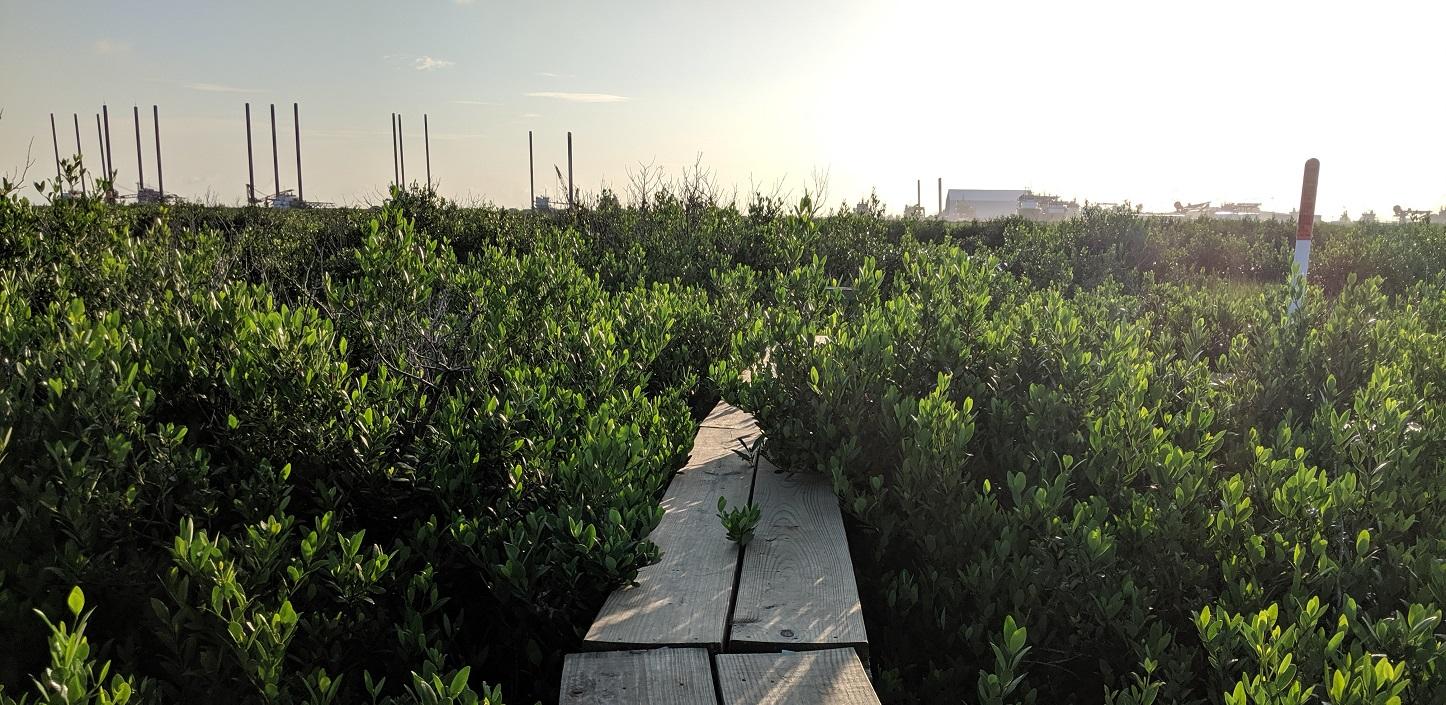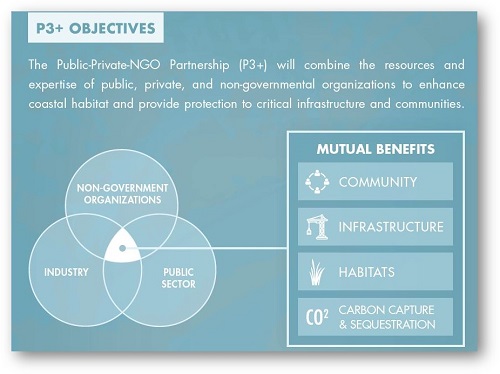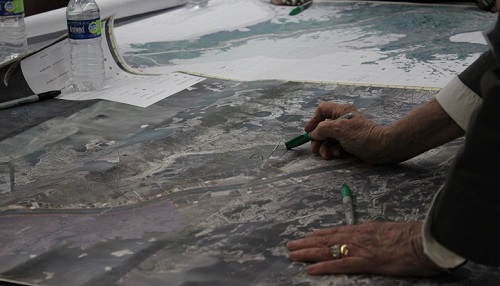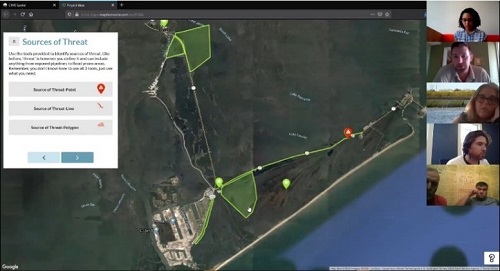
Case Study: The Water Institute of the Gulf
Port Fourchon: Supporting Resiliency on an Evolving Coast
Table of Contents
- Key Information
- Transferable Strategies
- Project Overview
- Challenges and Solutions
- Print this Case Study
Key Information
| Project Type | Project final design and permitting | ||
| Theme | Outreach and engagement: To ensure community support for nature-based reuse of dredged material in Port Fourchon, the Water Institute of the Gulf developed a robust outreach and engagement plan and worked with public and private partners to gather stakeholder input and potential project designs and sites. |
||
| Keywords | Modeling, project design, beneficial reuse, dredged materials, community engagement, education, community resilience | ||
| Organization (Type) | The Water Institute of the Gulf (Nonprofit) | ||
| Project Contacts (as of 2022) |
Mike Miner, Director of Applied Geosciences, mminer@thewaterinstitute.org Melissa Baustian, Coastal Ecologist, mbaustian@thewaterinstitute.org Scott Hemmerling, Director of Human Dimensions, shemmerling@thewaterinstitute.org Ioannis Georgiou, Director of Coastal and Deltaic Systems Modeling, igeorgiou@thewaterinstitute.org |
||
| Award Amount1 and Year | NFWF Award: $500,000 | Match: $650,000 | Award Year: 2019 |
| Location | Port Fourchon, Louisiana | ||
| Partners | Partnership for Our Working Coast | ||
| Multimedia and Additional Links2 |
|
||
1 The award amount does not necessarily reflect the total project cost. The match amount is based on the project proposal information. 2 Disclaimer: The opinions expressed in the multimedia and additional relevant links are those of the project team and their partners only and do not necessarily reflect the views of the National Fish and Wildlife Foundation (NFWF).
Transferable Strategies from this Case Study
- Engage stakeholders in project design: Involving stakeholders in the project planning and design phase allows them to express their needs and concerns from the onset. This process builds trust between the community and project leads, promotes buy-in, and allows the community to take ownership of the proposed solutions or strategies.
- Use participatory engagement and knowledge sharing approaches: While the scale and feasibility of community engagement may vary across projects, finding opportunities to involve community members and integrate local knowledge can help bridge information gaps and foster confidence in modeled outcomes.
- Conduct in-person or virtual site visits with project stakeholders: Site visits can provide context and additional hands-on understanding of a project and local site conditions. Virtual site “visits” or community education sessions can also be useful and even allow for wider community engagement beyond in-person stakeholder groups.
Project Overview: Port Fourchon—Supporting Resiliency on an Evolving Coast

The Partnership for Our Working Coast, led by the Water Institute of the Gulf (the Institute), successfully identified locations around Port Fourchon in Louisiana to place material from a dredging project in the port. Reusing the dredged material will provide community benefits such as enhanced community and habitat resilience, critical infrastructure protection, and enhanced carbon capture and sequestration.
In 2016, the Greater Lafourche Port Commission announced its plan to obtain federal regulatory approval to deepen Port Fourchon to support the needs of the offshore energy industry. To identify nature-based uses for the dredged materials, the Greater Lafourche Port Commission formed a public-private partnership called the Partnership for Our Working Coast. The Institute is leading the partnership in collaboration with industry partners Chevron, Shell, and Danos.1 The Institute conducted extensive outreach and education with community stakeholders to gather their input on the project design and candidate site selections.
Challenges and Solutions
The Institute realized that gaining stakeholder support for the candidate sites could be difficult based on an earlier project where some community members questioned the validity of modeling efforts and climate projections for the region. The project team also knew that stakeholders were concerned about the potential impacts of the dredged material on recreational, commercial, and charter fishing, as many communities in the area rely on the fishing industry for their livelihoods. To tackle these potential roadblocks, the Institute implemented a robust outreach and engagement plan designed to engage community members, help communicate future climate scenarios, build trust, and develop support for building coastal resilience in Port Fourchon.
Communicating Sound Science
Challenge:
The project team encountered challenges in effectively communicating sea level rise and subsidence projections to non-specialists, especially considering the inherent uncertainty in these projections and differing climate scenarios. In addition, some stakeholders were generally distrustful of the science-based planning process, particularly because government and industry groups were involved.
Solutions:

- Use modeling as an engagement tool: The team invited a community stakeholder group to engage in participatory modeling exercises. The group included representatives from local nonprofits, small businesses, educational institutions, and public service organizations. The exercises were designed to help visualize the effects of future climate scenarios (e.g., coastal flooding, sea level rise) in important areas of the community, such as open water areas in front of fishing camps. The exercises also illustrated how using the dredged material could enhance the resilience of these important areas in the face of worsening climatic events. Combining the climate models with local knowledge not only provided valuable inputs and contributed to a more comprehensive model, but also offered an opportunity to involve communities in project design and site selection.
- Conduct site visits: Following the modeling exercises, stakeholders visited some of the proposed areas where the dredged material could be used for resilience projects. The site visits provided ground truthing for the model inputs that stakeholders had contributed to in the modeling exercises. The visits also increased stakeholders’ appreciation for the project’s goals and benefits.
- Engage in participatory mapping: The stakeholder group also engaged in participatory mapping exercises before and during site visits. Participants identified locations they felt were of value on an area base map. They also identified threatened areas and considered where nature-based solutions could provide the maximum social value and resilience benefits. The mapping process provided an additional chance to build trust and helped the project team and community members reach consensus on prioritized locations for reusing the dredged material.
Adapting Community Engagement in a Virtual World
Challenge:

Successful community engagement activities depend on sustained dialogue and knowledge transfer between scientists and residents. With the onset of the COVID-19 pandemic in early 2020, planned in-person community meetings could not continue. In addition, most of the field work planned during 2020 could not occur due to travel restrictions.
Solutions:
- Use online platforms for engagement: Participatory mapping and modeling depend heavily on collecting local knowledge. In light of the COVID-19 pandemic, the engagement team developed a geospatial tool to allow community members to meet virtually and conduct mapping exercises using an online GIS mapping interface. The tool replicated the planned in-person activities, including local knowledge mapping, review of geospatial model inputs, and project development through participatory modeling. This process produced valuable qualitative and quantitative data to inform development of a suite of potential projects.
- Pursue alternatives to field work: Since the team could not conduct all the field work initially planned for the project, they devoted more time to modeling activities, which were effectively done through virtual meetings and workshops.
Print this Case Study (PDF version)